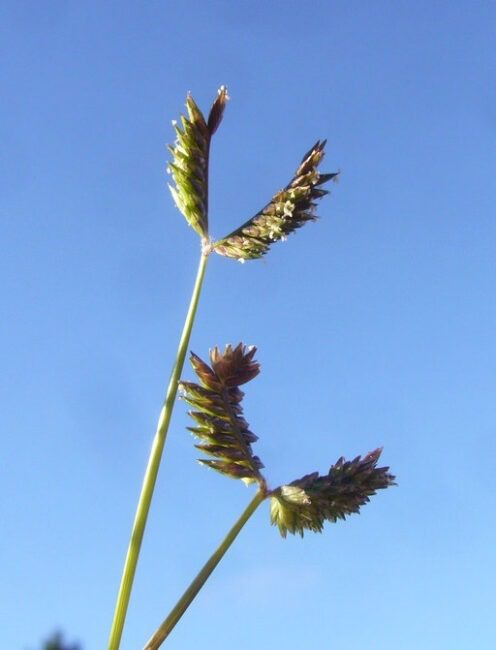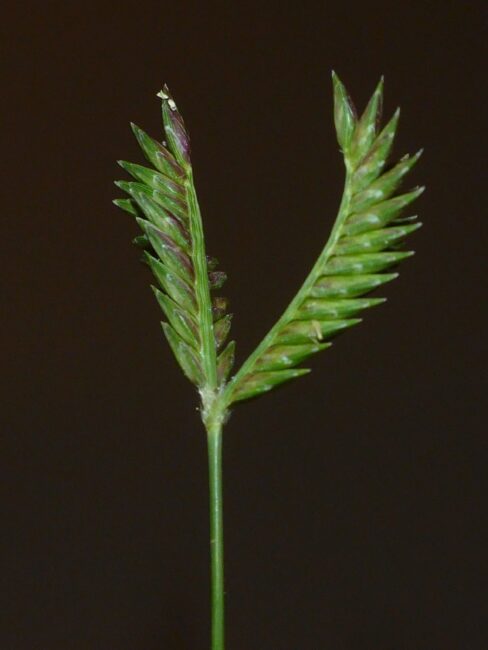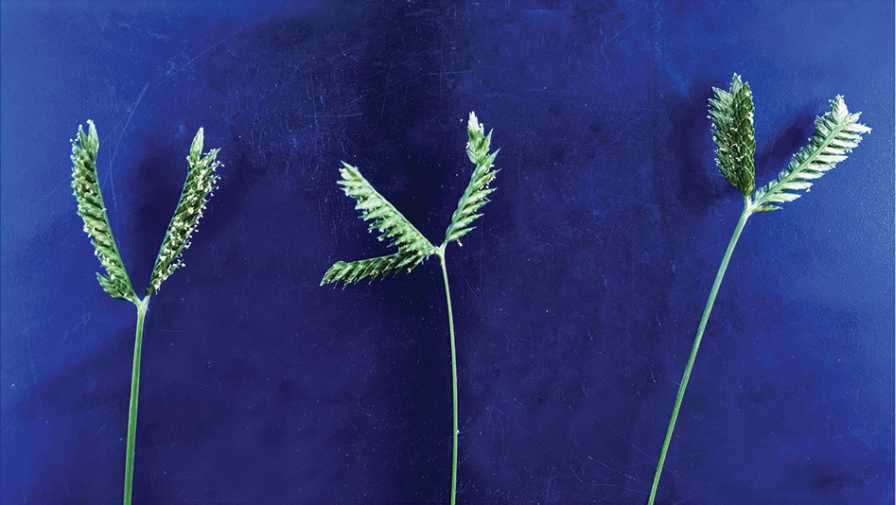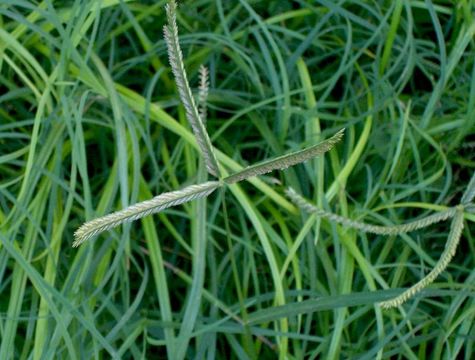Threespike goosegrass, scientifically known as Eleusine tristachya, is a grass species belonging to the Poaceae family. This plant is commonly found in various regions around the world, often in disturbed habitats, along roadsides, in lawns, and other open areas.
Threespike goosegrass is considered a weed in many agricultural and horticultural contexts due to its ability to grow rapidly and compete with cultivated crops or desired grass species.
Threespike goosegrass is an annual grass that typically grows to a height of 10 to 30 centimeters (4 to 12 inches). It has fine, slender stems with alternating leaves. The leaves are linear and may have a slightly rough texture. The seed heads, where it gets its name, consist of three spikes that radiate from a central point.
The seeds of Threespike goosegrass are small, elliptical, and often brown or greenish in color. Each seed head contains multiple seeds, contributing to its capacity for rapid proliferation.
This weed is highly adaptable and can be found in various environments, including lawns, agricultural fields, roadsides, and disturbed or compacted soils.
Threespike goosegrass primarily reproduces by seed. The plant produces numerous seeds throughout its lifecycle, and these seeds can remain viable in the soil for extended periods, contributing to its persistence as a weed.
Threespike goosegrass is considered a problematic weed in many contexts because it competes with desirable grass species and crops, reducing their growth and productivity.
To control Threespike goosegrass in agricultural and horticultural settings, integrated weed management approaches are employed. This may include cultural practices, herbicide applications, and mechanical methods like mowing.
While Threespike goosegrass is typically considered a weed, it can have some forage value for livestock in certain regions. However, its palatability and nutritional content vary, and it may not be a preferred forage option.
In some areas, Threespike goosegrass can exhibit invasive tendencies, particularly in disturbed or heavily trafficked environments. It can quickly colonize areas with compacted or degraded soils.
Read more: Squash Filaments: Economic Importance, Uses, and By-Products
How To Grow Threespike Goosegrass (Eleusine Tristachya)

Growing Threespike goosegrass (Eleusine tristachya) is not a typical objective for gardeners or farmers, as this plant is often considered a weed due to its competitive nature and ability to outcompete desirable grass species and crops. Nevertheless, understanding its growth requirements can help in managing and controlling it where necessary.
Here are some insights into how Threespike goosegrass grows;
1. Understanding Threespike Goosegrass: Threespike goosegrass is an annual grass that thrives in open, disturbed environments. While not a plant typically cultivated intentionally, understanding its growth can be useful for weed management.
2. Habitat and Adaptability: Threespike goosegrass can be found in a wide range of habitats, from agricultural fields to lawns and roadsides. It adapts well to disturbed or compacted soils.
3. Growth Conditions: This weed species prefers full sun but can tolerate partial shade. It is highly adaptable to a variety of soil types, including sandy, loamy, and clay soils.
4. Germination and Establishment: Threespike goosegrass reproduces primarily by seed. The seeds typically germinate when soil temperatures are warm, so emergence often occurs in late spring or early summer. It can also germinate in response to soil disturbances.
5. Seed Production: Threespike goosegrass is prolific in producing seeds. A single plant can produce numerous seeds, and these seeds can remain viable in the soil for several years.
6. Maintenance and Cultivation: While the cultivation of Threespike goosegrass is not a goal for most gardeners or farmers, managing its growth involves practices such as regular mowing or herbicide applications to prevent it from taking over cultivated areas.
7. Weed Management: In agricultural and horticultural settings, Threespike goosegrass is typically managed as a weed. Integrated weed management strategies, which may include cultural practices, chemical control, and mechanical methods, are employed to minimize its impact on crops or desired grass species.
8. Preventive Measures: Preventing soil disturbances and maintaining healthy turf or crop stands can help reduce the opportunities for Threespike goosegrass to establish and thrive.
9. Environmental Impact: In areas where Threespike goosegrass is invasive, it can negatively impact the growth of desired vegetation. Understanding its growth and reproductive patterns is essential for effective management and control.
10. Selective Herbicides: In agricultural and turfgrass settings, selective herbicides can be used to control Threespike goosegrass while preserving desirable grass species. Herbicides should be applied according to label instructions and best management practices.
11. Crop Rotation: In agricultural systems, rotating crops can help disrupt the life cycle of Threespike goosegrass and reduce its prevalence. It’s important to choose crops that are less susceptible to infestations by this weed.
12. Soil Improvement: Enhancing the health and structure of soil can discourage the growth of Threespike goosegrass. Proper soil testing and amendments can create conditions less favorable for this weed.
13. Early Detection and Intervention: Regular scouting of fields and gardens is crucial for early detection of Threespike goosegrass. Early intervention through timely weeding or herbicide applications can prevent the weed from becoming a significant problem.
14. Education and Awareness: Farmers, landscapers, and gardeners should educate themselves and their communities about the identification and control of Threespike goosegrass. Knowledge sharing can lead to more effective weed management.
15. Sustainable Weed Control: As part of sustainable and integrated weed management practices, consider non-chemical methods such as cultural controls, crop rotation, and targeted grazing by livestock to reduce Threespike goosegrass infestations.
While growing Threespike goosegrass is not a common objective, understanding its growth habits and employing effective weed management strategies is crucial for maintaining healthy crops and desirable grass species.
How To Care For Threespike Goosegrass (Eleusine Tristachya)

Caring for Threespike goosegrass (Eleusine tristachya) primarily involves management strategies to control its growth, especially when it is considered a weed in agricultural or horticultural contexts. This grass species can be problematic due to its competitive nature, but with the right approach, you can effectively manage it.
Here’s a detailed guide on how to care for Threespike goosegrass;
1. Identify and Monitor: The first step in managing Threespike goosegrass is accurate identification. Familiarize yourself with the plant’s appearance and growth habits. Regularly monitor your landscape or fields for signs of infestation.
2. Integrated Weed Management: Implement an integrated weed management (IWM) approach, which combines multiple strategies to control Threespike goosegrass effectively. IWM typically includes cultural, chemical, and mechanical methods.
3. Cultural Practices: Practices like proper crop rotation, adequate spacing between plants, and optimizing soil health can help reduce the competitiveness of Threespike goosegrass in agricultural settings.
4. Herbicide Application: In cases of severe infestation, selective herbicides labeled for use against Threespike goosegrass can be applied. Follow label instructions carefully, and consider pre-emergence and post-emergence herbicides as part of your control strategy.
5. Mowing and Mechanical Control: Regular mowing or mechanical control methods can be employed to manage Threespike goosegrass in non-crop areas, lawns, or along roadsides. Frequent mowing can prevent the grass from producing seeds and reduce its vigor.
6. Early Intervention: Control measures are most effective when applied early in the growth cycle of Threespike goosegrass. Early intervention can prevent the plant from producing a significant number of seeds, which contribute to its persistence.
7. Soil Management: Improving soil health through practices like proper fertilization, pH adjustment, and organic matter addition can enhance the competitiveness of desirable grass species, reducing the space and resources available to Threespike goosegrass.
8. Cultural Practices in Lawns: In home lawns, maintaining proper mowing height, aeration, and irrigation practices can help create conditions that favor desirable grasses while discouraging Threespike goosegrass.
9. Hand-Pulling: For small infestations, you can hand-pull Threespike goosegrass from your garden or lawn. Be sure to remove the entire plant, including its roots.
10. Preventive Measures: To prevent future infestations, practice good sanitation by cleaning tools, shoes, and equipment that may carry seeds from infested areas to non-infested areas.
11. Professional Advice: For larger agricultural or landscape settings, consider consulting with a professional agronomist or horticulturist who can provide tailored recommendations for Threespike goosegrass management.
Read Also: Types and Methods of Application of Fertilizers in Pasture Specie
The Uses and Benefits of Threespike Goosegrass (Eleusine Tristachya)

Threespike goosegrass (Eleusine tristachya), although primarily considered a weed, does have certain uses and potential benefits in specific contexts. It’s essential to understand these applications while also being mindful of its potential weediness.
Here’s a detailed look at the uses and benefits of Threespike goosegrass;
1. Forage for Livestock: Threespike goosegrass can serve as a forage source for livestock in some regions. While it may not be a preferred forage option, it can contribute to animal diets when other forage is scarce.
2. Erosion Control: In areas with compacted or degraded soils, Threespike goosegrass can be used for erosion control. Its rapid growth and extensive root system help stabilize soil, preventing erosion in vulnerable locations.
3. Soil Improvement: Threespike goosegrass, as a grass species, contributes organic matter to the soil when it decomposes. This organic matter enriches the soil, improving its structure and nutrient content over time.
4. Biodiversity Support: While it can be invasive and compete with desirable species, Threespike goosegrass can provide habitat and forage for certain insects and small wildlife, potentially contributing to local biodiversity.
5. Indicator of Soil Disturbance: In some cases, the presence of Threespike goosegrass can serve as an indicator of soil disturbance. It tends to colonize areas with compacted or disturbed soils, providing a visual cue for necessary soil improvement measures.
6. Potential Medicinal Uses: In traditional medicine in some regions, certain parts of Threespike goosegrass have been used for their alleged medicinal properties. However, it’s important to note that these uses are not widely documented or scientifically validated.
7. Early Succession Species: Threespike goosegrass is considered an early succession species, meaning it often colonizes open or disturbed areas. This can have ecological importance, as it helps prepare the ground for the establishment of other plant species in the longer term.
8. Organic Matter Decomposition: As Threespike goosegrass grows and matures, it contributes to the cycling of organic matter in the ecosystem. When this grass species dies back and decomposes, it adds organic material to the soil, enhancing its fertility and structure.
9. Educational Value: Threespike goosegrass can be a valuable teaching tool in educational settings. It provides opportunities to study plant adaptations, ecological interactions, and the role of pioneer species in ecosystem development.
10. Support for Wildlife in Marginal Habitats: In areas where little else grows due to poor soil conditions or high traffic, Threespike goosegrass can offer cover and food sources for small wildlife, including insects and birds.
11. Controlled Grazing and Pasture Management: In some pasture management strategies, controlled grazing of Threespike goosegrass can be integrated to prevent its overgrowth while providing livestock with additional forage options.
In summary, while Threespike goosegrass (Eleusine tristachya) is primarily considered a weed and may require management in cultivated environments, it does have certain ecological and practical uses in specific contexts. Recognizing its adaptability and potential contributions to soil health and early succession ecosystems is important, particularly in regions where it naturally occurs or in disturbed habitats.
However, it is critical to manage and monitor its growth to prevent it from becoming invasive and competing with desired plant species in gardens, lawns, and agricultural fields.
Frequently Asked Questions About Threespike Goosegrass (Eleusine Tristachya)
Threespike goosegrass (Eleusine tristachya) is a grass species known for its weed-like characteristics and adaptability to various environments.
Here, we’ll explore some frequently asked questions (FAQs) about Threespike goosegrass and provide detailed answers to help you better understand this plant and its management:
1. What is Threespike goosegrass, and why is it considered a weed?
Threespike goosegrass is an annual grass species that is often considered a weed due to its rapid growth, prolific seed production, and ability to compete with desired grass species and crops. It can outcompete cultivated plants and reduce agricultural and horticultural yields.
2. Where is Threespike goosegrass commonly found?
Threespike goosegrass is a cosmopolitan weed and can be found in a wide range of environments, including lawns, roadsides, agricultural fields, gardens, and disturbed or compacted soils. It thrives in areas with high human activity and disturbance.
3. How can I identify Threespike goosegrass?
Threespike goosegrass is typically a low-growing grass with slender stems and long, narrow leaves. Its distinctive feature is the seed head, which consists of three spikes radiating from a central point, resembling a goose’s footprints.
4. What is the life cycle of Threespike goosegrass?
Threespike goosegrass is an annual plant, meaning it completes its life cycle within a year. It reproduces primarily by producing seeds, which are dispersed to start new plants.
5. What makes Threespike goosegrass problematic in agriculture and landscaping?
Threespike goosegrass can rapidly establish itself, outcompeting desired crops or grass species for nutrients, water, and sunlight. It negatively impacts the yield and quality of agricultural produce and can disrupt the aesthetic value of lawns and gardens.
6. How can Threespike goosegrass be managed in agricultural and horticultural settings?
Integrated weed management practices are typically employed to control Threespike goosegrass. This may involve cultural practices, herbicide applications, and mechanical methods such as mowing or tilling. Effective weed management strategies depend on the specific context and goals.
7. Is Threespike goosegrass ever used as a forage source for livestock?
Threespike goosegrass can have some forage value for livestock in certain regions. However, its palatability and nutritional content can vary, and it may not be a preferred forage option. Other grass species are often more suitable for livestock grazing.
8. Does Threespike goosegrass have any ecological benefits?
While Threespike goosegrass is primarily viewed as a weed in many contexts, it can help prevent soil erosion in disturbed areas. However, its ecological benefits are generally outweighed by its negative impacts in agricultural and landscaped settings.
9. Can Threespike goosegrass be controlled without the use of herbicides?
Yes, cultural practices like maintaining healthy, competitive grass stands, proper mowing and cultivation, and early identification and removal of Threespike goosegrass can help manage its growth without relying solely on herbicides.
10. Is Threespike goosegrass an invasive species in certain regions?
In some areas, Threespike goosegrass can exhibit invasive tendencies, particularly in heavily trafficked or degraded environments. It has the potential to colonize areas with compacted or disturbed soils rapidly.
In conclusion, Threespike goosegrass is a common weed known for its competitive nature and adaptability. Effective management is essential to control its spread and minimize its negative impact on agriculture, landscaping, and natural ecosystems.
Integrated weed management, cultural practices, and herbicides are tools used to address the challenges posed by Threespike goosegrass in various contexts.

